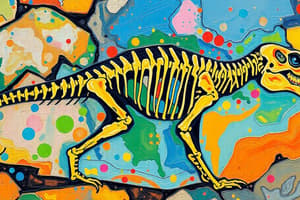Podcast
Questions and Answers
What is paleontology primarily concerned with?
What is paleontology primarily concerned with?
- The study of ancient fossils (correct)
- The study of animal behavior
- The study of living species
- The study of geological formations
What increases the likelihood of an organism being fossilized?
What increases the likelihood of an organism being fossilized?
- Being buried quickly (correct)
- Having a high oxygen environment
- Living in water
- Being soft-bodied
Which of the following factors does NOT affect fossil preservation?
Which of the following factors does NOT affect fossil preservation?
- Present environmental conditions
- The organism's body type
- Geographical location (correct)
- Rapid decomposition
Which statement accurately reflects Cuvier's observations about fossils?
Which statement accurately reflects Cuvier's observations about fossils?
Which of the following best describes homologous structures?
Which of the following best describes homologous structures?
What concept explains that geographically close species are more related?
What concept explains that geographically close species are more related?
What evolutionary significance does Archaeopteryx hold?
What evolutionary significance does Archaeopteryx hold?
Which of the following correctly defines analogous structures?
Which of the following correctly defines analogous structures?
What do insect wings primarily rely on for support?
What do insect wings primarily rely on for support?
Which of the following describes a vestigial structure?
Which of the following describes a vestigial structure?
How does competition influence evolution in a population?
How does competition influence evolution in a population?
What can be inferred about the relatedness of two species based on DNA comparisons?
What can be inferred about the relatedness of two species based on DNA comparisons?
What was a limitation in Darwin's understanding of evolution?
What was a limitation in Darwin's understanding of evolution?
What best describes the changes in allele frequencies within a gene pool?
What best describes the changes in allele frequencies within a gene pool?
Which of the following is an example of pseudogenes?
Which of the following is an example of pseudogenes?
What has enhanced our understanding of evolution in modern paleontology?
What has enhanced our understanding of evolution in modern paleontology?
Flashcards are hidden until you start studying
Study Notes
Fossil Record
- Fossils are preserved remnants of ancient organisms.
- Fossils are studied by the science of Paleontology.
- Fossils are found in sedimentary rocks, providing clues about organisms that lived during different Earth periods.
- Fossils form when an organism's remains are gradually replaced by minerals.
- Fossil formation is uncommon, as decomposition often happens faster than fossilization.
- Hard-bodied organisms are more likely to fossilize than soft-bodied ones.
- Organisms can be preserved in amber, volcanic ash, and ice.
- Cuvier observed more complex fossils in younger rock layers and less complex fossils in deeper and older rock layers.
- Lyell recognized that geological changes happen slowly and gradually, not abruptly.
- Fossils show intermediary links between organisms, revealing common characteristics.
- Archaeopteryx, a 150-million-year-old fossil, shows characteristics of both reptiles and birds, suggesting birds evolved from reptiles (or dinosaurs).
Biogeography
- Biogeography is the study of the geographical distribution of organisms, based on living species and fossils.
- Lemurs are endemic to Madagascar, indicating they once existed across Africa.
- Organisms geographically close are more closely related than those far apart, regardless of environment.
- Darwin noted remote islands become populated by species arriving via water or air, evolving into new species over time.
Anatomy
- Bone structure and function can reveal evolutionary evidence.
- Homologous structures share similar developmental origin with similar bone, muscle, ligament, tendon, and blood vessel counts, suggesting common ancestry.
- Embryology highlights evolutionary relationships through similarities in developmental stages.
- Analogous structures have differing evolutionary origins but perform similar functions (like bird wings and insect wings).
- Vestigial structures are non-functional in current organisms but were functional in ancestors. For example, pelvic bones in modern whales have no function, but indicate a terrestrial ancestor.
Competition
- Nature favors certain individuals over others.
- Competition exists between individuals of the same species.
Molecular Biology
- Evolutionary relationships are reflected in DNA.
- Relatedness can be determined by comparing DNA sequences.
- The greater the similarity in DNA, the closer the relationship.
- Phylogenetic trees show relationships based on DNA comparisons.
Modern Theory of Evolution
- Darwin didn't understand how traits are inherited and pass from one generation to the next.
- Mendel focused on trait inheritance.
- Evolutionary change is described as shifts in allele frequencies within a gene pool (natural selection favors certain alleles).
- Mutations contribute to genetic variation.
Pseudogenes
- Pseudogenes are inactive genes that have undergone mutations.
- Dolphins have many olfactory receptor genes but use a small portion, demonstrating adaptation to their underwater environment.
Modern Paleontology
- Enhanced evolutionary understanding through new fossil discoveries (early humans, primitive whales, feathered dinosaurs).
- Plate tectonics explains the movement of Earth's crust.
- Radiometric dating determines Earth's age and rock layer ages using radioisotope decay.
Modern Synthesis
- Modern evolutionary biology incorporates advancements in molecular genetics, geology, and paleontology.
- It explains complex adaptations and structures, and how new species evolve.
Studying That Suits You
Use AI to generate personalized quizzes and flashcards to suit your learning preferences.




